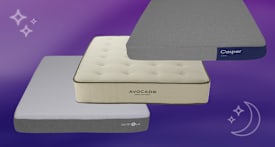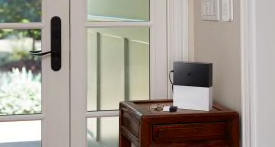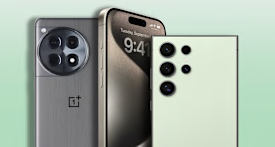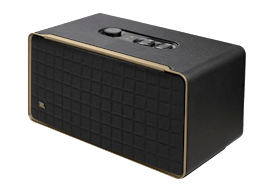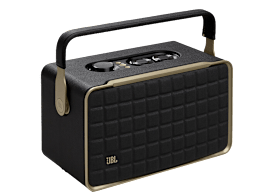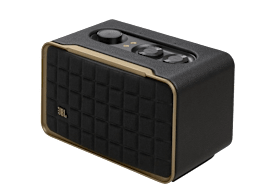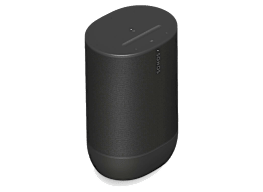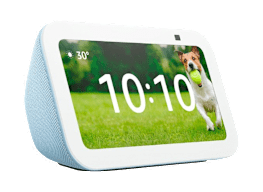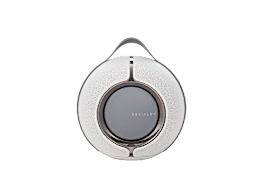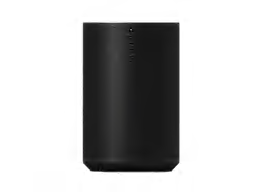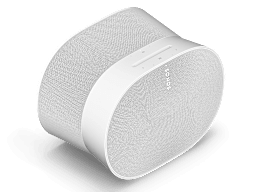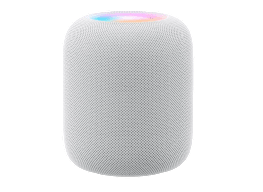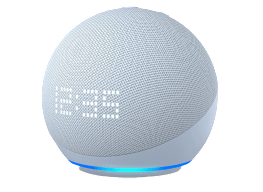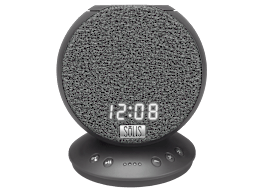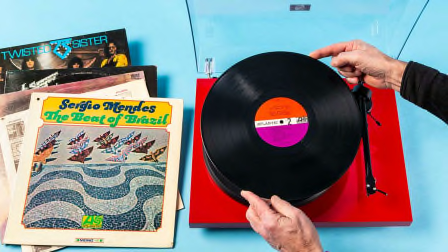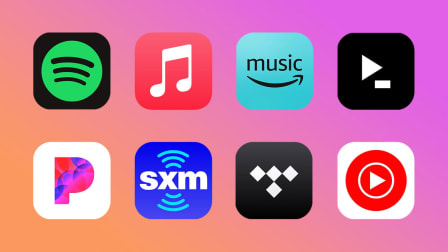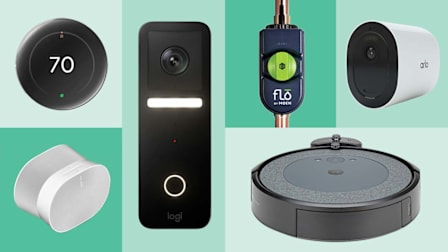Final Results: Google Nest Hub With Sleep Tracking
Can a smart speaker monitor your slumber as well as a smartwatch? We took a look at the Nest Hub's new feature, sound quality, and ease of use.
When you shop through retailer links on our site, we may earn affiliate commissions. 100% of the fees we collect are used to support our nonprofit mission. Learn more.

"So how did you sleep last night?"
When that question came up in our bedroom, it was always between my wife, Sally, and me. But one weekend not long ago we made it a threesome, thanks to the newest Google Nest Hub smart speaker.
The Google Nest Hub is a $99 smart speaker with a 7-inch touch screen that doesn't look much different from its predecessor, also called the Google Nest Hub.
But this second-generation model includes a new feature—touch-free sleep tracking—that all but demands that you put it in the bedroom instead of on the kitchen counter, where most smart speakers with screens have resided.
And so, in addition to the usual smart speaker testing performed in our labs, we took a look at the Nest Hub's sleep-tracking function to see how it compared with that on wearable devices like the Apple Watch and Oura Ring.
Features and Setup
At first glance, the Nest Hub is a pretty conventional smart speaker with a screen. The smallish touch screen can be set to display a smart speaker menu, clock, or gallery of images, acting as a digital picture frame.
Like most smart screens, it can also play video, and it's especially adept at serving up content from Google-owned YouTube. It's not like watching on a 65-inch OLED but is more gratifying than your phone, especially when you're close to the screen.
The Nest Hub, which is powered by Google Assistant, can also control smart home devices like a Nest thermostat or smart bulbs, although I didn't try those functions.
The speaker features a smart-alarm function that can be set with a weekly schedule and a wake function, called Sunrise Alarm, that gradually increases the brightness of the display when it's almost time to get up. It offers a wide variety of wake sounds, many with a spalike vibe designed to rouse you gently.
Before you use it, the Nest Hub needs to be set up on your nightstand or another mattress-level surface near the head of your bed. The relatively quick process requires you to lie still in bed for a few minutes while the Soli sensor does its thing.
For the best results, Google suggests you remove any objects between you and the speaker. And once it's positioned, the Nest Hub shouldn't be moved.
Having a smart speaker in your bedroom prompts some privacy concerns. The Nest Hub doesn't have a camera, which addresses one issue (though you can't make video calls). The mic can also be turned off with a switch on the back.
With a notice on the screen, the device does make it clear to you—or a partner or guest—when it's in Sleep Sensing mode. However, once you turn on Sleep Sensing and log in to the Google Fit smartphone app, the Nest Hub will keep recording your sleep data and sending it to Google.
The raw sound data—breathing, coughing, etc.—as well as movement information from the Soli sensor is, according to Google, processed within the device and not sent to Google's cloud servers, where most Google Assistant requests are processed.
"Devices that sense your activity in the background raise many privacy concerns," says David Choffnes, a smart speaker researcher and associate professor at Northeastern University's Khoury College of Computer Science.
"If what Google is saying is correct, it is good for privacy that they are not transmitting audio of breathing or coughing to their cloud," he says. "However, even the inferred data about sleep and health is highly sensitive, and the privacy implications of collecting this data are not addressed by simply not transmitting audio."
Choffnes adds that his lab would need to run experiments on the Nest Hub to determine the validity of Google's privacy claim.
I found it can take more than an hour in the morning for the Nest Hub to process the results from the night before, which eliminates the instant gratification factor that wearable sleep trackers can provide.
What We Learned
I used the sleep tracker on the Nest Hub for five consecutive nights and got mixed results.
The first night was fine, with the device recording around 7 hours of sleep, which basically agreed with both my subjective evaluation—I woke up without my alarm and felt generally well-rested—as well as the results from the sleep tracking function on my Oura Ring.
On some subsequent nights, the Nest Hub seemed to either over- or underreport my sleep. On the second morning, when I brought my laptop back to bed and started working on a news article while still in my pj's, it added an hour to my sleep duration.
The following night, when I was watching the Tom Hanks movie "News of the World" with my wife, the Nest Hub again seemed to think I was sleeping.
In the morning, the Nest Hub reported that I had slept 11 hours and 17 minutes, although when I later checked the "processed data" on the Google Fit app, my sleep time was revised downward to a more plausible 7 hours and 48 minutes.
Another night, the Nest Hub logged more than 2 hoursless sleep time than my Oura ring.
In its product literature, Google warns that "device placement and nearby people, pets, or noises can cause inaccurate readings." So it's entirely possible that my golden retriever Rugby is to blame for some of the odd results. (She sometimes snores.)
"Minor differences between sleep trackers are common and don’t reflect any accuracy problem with either device," says Ashton Udall, senior product manager for Google Nest. "The most important thing about sleep tracking . . . is monitoring changes over time and how those relate to how you’re feeling."
And the variations come as no surprise to sleep experts who explain that all consumer-grade sleep trackers have limitations when it comes to accuracy.
"All of these devices have constraints, and weaknesses. None of them are perfect," says Michael Grandner, director of the Sleep & Health Research Program at the University of Arizona School of Medicine. "The question isn't whether it's accurate, the question is 'How is it inaccurate, and how do you interpret that information?' "
With new devices using new technology, like the Nest Hub, consumers should be careful not to take the results too literally, Grandner says.
My experience with the Nest Hub was admittedly limited; five nights is a small sample. Going forward, I could change certain practices to reduce discrepancies—watching TV downstairs or working in my office—or just learn to treat those unusual results as outliers.
A month's worth of information from the Nest Hub, which can be found both on the device and in more granular form on the Google Fit app, would probably allow me to draw inferences about how much sleep I'm getting and what factors affect that.
In short, the Nest Hub is easier to use than a wearable, and though its sleep tracking information isn't perfect, it's probably useful if your goal is simply to understand and improve your sleep habits.
How the Nest Hub Fared in Our Labs
As with its sonically similar predecessor, the Nest Hub's sound leaves quite a bit to be desired. Our testers report that there's not much deep bass, and the highs are a bit thin and sizzly.
Worse yet, the all-important-midrange, where most voices and instruments live, delivered all sorts of distortions. "Thin, raspy, plasticky, and hazy" are some of the less-than-complimentary adjectives our testers used to describe the speaker's audio quality.
In the end, it falls short of what you get from the latest version of the Amazon Echo Show 8, which is similar in size and price but much more pleasant to listen to.
The ease of use and versatility scores, however, are a different story. As with most smart speakers with screens, the Nest Hub was simple to set up, although our testers noted that some of the controls—including the microphone mute—are not as obvious or well-marked as they could be.
The speaker's versatility is another strong point. The Nest Hub can work as part of a multiroom system with other Google devices, although it can't be paired in stereo with another unit. Our testers note that the newest Nest Hub supports calling and messaging but not texting. It lacks speakerphone capability, too.
Should You Buy a Google Nest Hub?
Does the new Google Nest Hub deserve a spot on your bedside table? The device offers an impressive amount of technology for less than $100, only $10 more than the first-gen model. It pairs the do-what-I-say functionality of a smart speaker with some cool tricks from a tablet or smart frame. And in that way, the model should merit serious consideration for a spot on your kitchen island or even your desk.
Our testers find the model to be versatile and easy to use, but the below-average sound quality makes it better suited for podcasts and weather forecasts than listening to music.
Sharing your bedroom with the Nest Hub? That's a more personal question. The sleep tracking functionality is pretty impressive even if its conclusions don't completely jibe with a wearable unit. But in order to pull off the sleep tracking feature, the Nest Hub essentially listens to every breath you take as if it's a "Hey, Google" wake word and records you all night long.
As my wife, Sally, said when I explained how the Nest Hub works, "That's kind of creepy." But, of course, your reactions may vary.
So while I'll probably miss the Nest Hub's retro-cool flip clock display, I think I'll go back to answering the question "So how'd you sleep?" with words instead of data, and make my bedroom a smart-speaker-free zone again.




